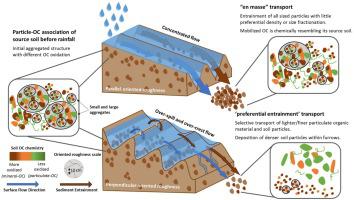Soil and Tillage Research ( IF 6.1 ) Pub Date : 2020-11-23 , DOI: 10.1016/j.still.2020.104807 Tingyu Hou , Timothy R. Filley , Yanan Tong , Benjamin Abban , Sarmistha Singh , A.N. Thanos Papanicolaou , Kenneth M. Wacha , Christopher G. Wilson , Indrajeet Chaubey

|
Intensive row crop agriculture on loess mantled hillslopes in the upper Midwest, USA, accelerates soil erosion and the loss of organic matter by increasing soil aggregate breakdown, changing surface roughness patterns, and leaving soil exposed to rainfall and wind for much of the year. There is a knowledge gap, however, in relating how the dynamics of soil erosion on hillslopes control landscape heterogeneity in terms of particle size, surface soil organic chemistry and reactivity. Simulated rainfall experiments on intensively managed hillslopes in the Clear Creek, IA watershed, USA, revealed that tillage-induced, oriented roughness controls the amount and organic geochemistry of soil particles mobilized downhill. The average discharge rate of mobilized sediment was nearly 30-fold higher when the tillage orientation was parallel to the runoff direction compared to when the tillage orientation (i.e. contour tillage) was perpendicular to the runoff direction. Mobilized particles under contour tillage were higher in organic carbon (OC) content and were relatively less decomposed, based on lignin chemistry, compared to analogous particles under the parallel tillage orientation. Contour tillage increased deposition of denser particles within the furrows and increased the release of the finer, lighter, and organic-rich material during over-spilling and contour breach. Our findings have important implications for understanding how the interaction of tillage practices and event-based erosion influences the spatial heterogeneity of soil geochemistry and potentially soil health across agricultural landscapes as well as understanding what controls the geochemical signature of soil erosion into streams.
中文翻译:

耕作引起的表层土壤粗糙度控制着侵蚀早期侵蚀颗粒的化学和物理性质
在美国中西部上部的黄土覆盖的山坡上,集约化耕作农业通过增加土壤团聚体的分解,改变表面粗糙度的模式以及在一年中的大部分时间使土壤暴露于降雨和风中而加速了土壤侵蚀和有机物的损失。然而,在粒度,表层土壤有机化学和反应性等方面,关于坡地土壤侵蚀的动力学如何控制景观异质性存在知识差距。在美国IA流域Clear Creek的集约化管理山坡上进行的模拟降雨实验表明,耕作诱导的定向粗糙度控制着下坡移动的土壤颗粒的数量和有机地球化学。与耕作方向(即等高耕作)垂直于径流方向相比,耕作方向平行于径流方向时,动员沉积物的平均排放速率高出近30倍。与平行耕作取向下的类似颗粒相比,根据木质素化学分析,等高耕作下的动员颗粒有机碳(OC)含量较高且分解相对较少。轮廓耕作增加了沟内更密颗粒的沉积,并增加了过度起球和轮廓破坏期间较细,较轻和富含有机物的物质的释放。











































 京公网安备 11010802027423号
京公网安备 11010802027423号